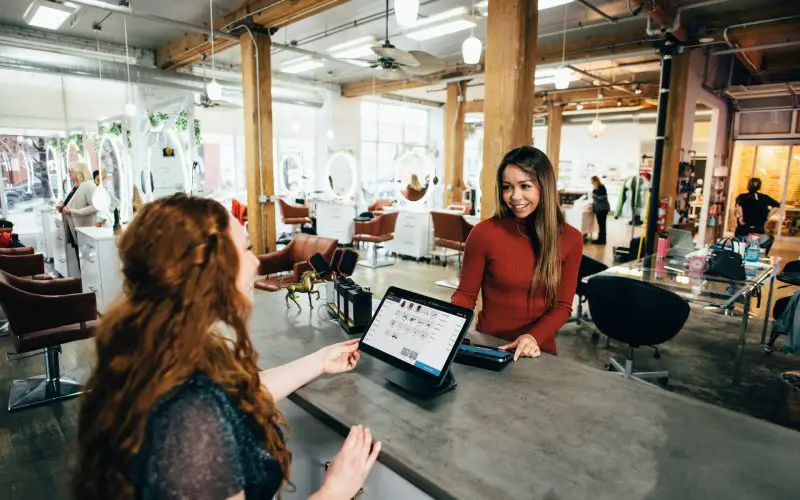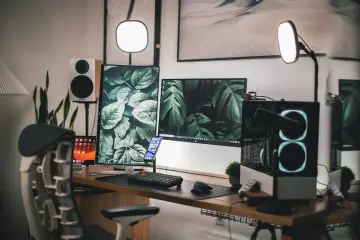As we know, technology is not just about fancy gadgets. It’s about creating better experiences for people, especially in shopping and services. This change is like adding a special flavour to your favourite dish. It makes everything better. Here are some ways businesses in retail and service industries are using technology to make their customers smile.
1. Virtual Try-Ons in Clothing Stores
Imagine going into a clothing store and trying on clothes without actually changing into them. Sounds like magic, right? Well, it’s not magic; it’s technology! Some clothing stores now have virtual fitting rooms. You stand in front of a screen, and it shows you wearing different outfits. You can switch between dresses, shirts, or pants with a simple click. This tech makes shopping fun and fast. It’s like playing a dress-up game, but with real clothes!
2. Augmented Reality in Furniture Stores
Buying furniture can be tricky. Will that sofa look good in your living room? Thanks to augmented reality (AR), you don’t have to guess anymore. Some furniture stores have apps that let you see how a piece of furniture looks in your space. You point your phone’s camera at the room, and the app places a virtual image of the furniture there. It’s like having a preview before you buy. This technology helps customers make better choices and feel happier with their purchases.
3. Chatbots for 24/7 Customer Service
Ever had a question about a product late at night? Now, many companies have chatbots on their websites. These are like friendly robots that can answer your questions any time of the day. For example, if you’re browsing an online casino site like https://www.spinia.com/en-CA and have a question, a chatbot can provide instant answers. This means you don’t have to wait for the store to open to get help. It’s like having a helpful assistant always ready to answer your queries.
4. Personalised Shopping Experiences
Some stores are using technology to give you a shopping experience that’s all about you. They remember your size, style, and preferences. The next time you shop, they suggest items that you might like. It’s like the store knows you personally. This personal touch makes shopping feel special and saves you time.
5. Mobile Payment for Quick Checkouts
Gone are the days of standing in long lines to pay for your shopping. Thanks to mobile payment technology, the checkout process has been transformed into a swift and hassle-free experience. Many stores have adopted systems where you can simply use your smartphone to pay. This method is not only fast but also adds an extra layer of security to your transactions.
Using your phone to pay is as simple as tapping it on a card reader. The technology behind this is called Near Field Communication (NFC), and it’s what makes mobile payments super quick and easy. This convenience has encouraged more people to shop in-store, bringing back the joy of browsing and picking items off shelves without the dread of long lines.
The beauty of mobile payments lies in their versatility. Whether you’re at a grocery store, a clothing boutique, or even a local farmer’s market, the ability to pay with your phone has made shopping smoother and more enjoyable. Plus, it’s a great way to keep track of your spending, as most mobile payment apps provide a history of your transactions.
6. Interactive Menus in Restaurants
Dining out has gotten a tech-savvy makeover with the introduction of interactive menus. Many restaurants now offer tablets instead of traditional paper menus. These digital menus are not only visually appealing, with high-quality images of dishes, but they also provide detailed descriptions and ingredient lists. This is particularly helpful for those with dietary restrictions or allergies.
Interactive menus often include features like ordering from the tablet, calling a server, and even paying the bill. This technology streamlines the dining experience, allowing more time for conversation and enjoyment. For restaurants, it means efficient service and happy customers.
Additionally, interactive menus can be updated quickly and easily, which is great for restaurants that change their offerings regularly. It also allows for instant feedback from customers, which restaurants can use to improve their service and menu items.
7. Online Booking Systems for Services
Online booking systems have revolutionised the way we schedule appointments for various services. From hair salons to massage parlours, and even medical consultations, the ability to book online has made life much easier. These systems allow you to view available slots, select the service you need, and book an appointment without ever having to make a call.
This convenience extends beyond just making appointments. Many online booking systems let you choose your service provider, see their availability, and even read reviews from other customers. This added information helps in making informed decisions and ensures a satisfying experience.
For businesses, online booking systems mean better organisation and efficiency. They can manage their appointments more effectively, reduce no-shows with reminder features, and provide better service to their clients. It also helps in gathering customer data, which can be used to tailor services and offers, enhancing the overall customer experience.
The integration of technology in everyday services like shopping and dining has brought a level of convenience and efficiency that was previously unimagined. From mobile payments to interactive menus and online booking systems, technology has not only simplified processes but also enhanced the overall customer experience. As technology continues to evolve, we can only expect these services to become more innovative and customer-friendly.
8. Feedback Systems for Continuous Improvement
Many businesses now have digital feedback systems. After shopping or using a service, you can quickly give your feedback through a digital kiosk or an online survey. This helps businesses know what they’re doing right and what they need to improve. It’s a win-win businesses get to improve, and customers get better experiences.
In conclusion, technology in retail and service industries is all about making life easier and more fun for customers. From virtual try-ons to chatbots, personalised shopping to mobile payments, every bit of tech adds value. It’s about understanding what customers need and giving it to them in the best way possible. Technology has opened up a world where shopping and services are not just necessary activities but enjoyable experiences. As these technologies continue to grow and evolve, we can only imagine how much more exciting and convenient our shopping and service experiences will become.








